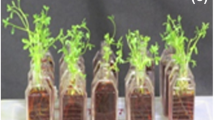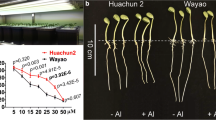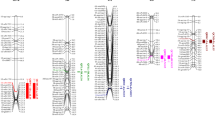Abstract
Association mapping (AM) combined with linkage mapping (LM) was executed to identify molecular markers and QTL regions associated with aluminum (Al) tolerance using relative root elongation (RRE) in hydroponics as an indicator. A set of 188 soybean cultivars released in Yellow and Changjiang River Valleys and 184 recombinant inbred lines (RIL) derived from a cross KF No. 1 (tolerant) × NN1138-2 (susceptible) was used in the study. Inheritance analysis of the RIL population suggested four major genes and polygenes controlled Al-tolerance. Further, LM indicated four additive and four epistatic QTL pairs plus a collective unmapped minor QTL were responsible for Al-tolerance and explained 29.39, 18.75 and 43.07 % of the phenotypic variation (PV), respectively. In the set of released cultivars, AM identified 11 markers significant at P < 0.03 that explained 85.2 % of PV with six of which at P < 0.01 accounted for 57.9 % of PV. Ten of these eleven AM marker-QTL were mapped within range of ~2.0 cM to ~43.0 cM outside confidence interval of respective Al-tolerance QTL in previous studies. Five markers, Satt209, Sat_364, Sat_240, Sct_190 and Satt284, were located near Al-tolerance QTL regions in this and previous LM studies. Thus, the two methods confirmed these markers as being the most likely candidate regions for Al-tolerance. Allele effects relative to the population mean for the 11 QTL were estimated, and the allele A210 of Satt209 showed greatest phenotypic effect on Al-tolerance. The two most favorable alleles from each of the 11 marker loci and their carriers were identified, and accordingly the genetic constitution of Al-tolerance for the 188 cultivars was dissected as a QTL-allele matrix. Therefore, marker-assisted pairing of crosses and marker-assisted selection of progenies can be carried out to pyramid favorable alleles of all the 11 loci. This marker-assisted breeding procedure was designated as breeding by design using a QTL-allele matrix.

Similar content being viewed by others
References
Agrama HA, Yan WG (2009) Association mapping of straighthead disorder induced by arsenic in Oryza sativa. Plant Breed 128:551–558
Bianchi-Hall CM, Carter TE Jr, Bailey MA, Mian MAR, Rufty TW, Ashley DA, Boerma HR, Arellano C, Hussey RS, Parrott WA (2000) Aluminum tolerance associated with quantitative trait loci derived from soybean PI 416937 in hydroponics. Crop Sci 40:538–545
Breseghello F, Sorrells ME (2006a) Association mapping of kernel size and milling quality in wheat (Triticum aestivum L.) cultivars. Genetics 172:1165–1177
Breseghello F, Sorrells ME (2006b) Association analysis as a strategy for improvement of quantitative traits in plants. Crop Sci 46:1323–1330
Buckler ES, Thornsberry JM (2002) Plant molecular diversity and applications to genomics. Curr Opin Plant Biol 5:107–111
Campbell KAG, Carter TE Jr (1990) Aluminum tolerance in soybean: I. Genotypic correlation and repeatability of solution culture and greenhouse screening methods. Crop Sci 30:1049–1054
Ching A, Caldwell KS, Jung M, Dolan M, Smith OS, Tingey S, Morgante M, Rafalski AJ (2002) SNP frequency, haplotype structure and linkage disequilibrium in elite maize inbred lines. BMC Genet 3:19. doi:10.1186/1471-2156-3-19
Cui Z, Carter TE Jr, Burton JW (2000) Genetic diversity patterns in Chinese soybean cultivars based on coefficient of parentage. Crop Sci 40:1780–1793
Delhazie E, Ryan PR (1995) Aluminum toxicity and tolerance in plants. Plant Physiol 107:315–321
Dong YS, Zhao L, Liu MB, Wang ZW, Jin ZQ, Sun H (2004) The genetic diversity of cultivated soybean grown in China. Theor Appl Genet 108:931–936
Doyle JJ, Doyle JI (1990) Isolation of plant DNA from fresh tissue. Focus 12:147–151
Fehr WR (1987) Principles of cultivar development, vol 1: Theory and technique. McGraw Hill Inc, New York
Flint-Garcia SA, Thornsberry JM, Buckler ES (2003) Structure of linkage disequilibrium in plants. Annu Rev Plant Biol 54:357–374
Flint-Garcia SA, Thuillet AC, Yu J, Pressoir G, Romero SM, Mitchell SE, Doebley J, Kresovich S, Goodman MM, Buckler ES (2005) Maize association population: a high-resolution platform for quantitative trait locus dissection. Plant J 44:1054–1064
Foy CD, Fleming AL, Burns GR, Armiger WH (1967) Characterisation of differential aluminium tolerance among varieties of wheat and barley. Soil Sci Soc Am Proc 31:513–521
Foy CD, Duke JA, Devine TE (1992) Tolerance of soybean germplasm to an acid Tatum subsoil. J Plant Nutr 15:527–547
Gai JY (2006) Segregation analysis on genetic system of quantitative traits in plants. Front Biol China 1:85–92
Gai JY, Chen L, Zhang YH, Zhao TJ, Xing GN, Xing H (2012) Genome-wide genetic dissection of germplasm resources, and implications for breeding by design in soybean. Breed Sci 61:495–510
Habier D, Fernando RL, Deckkers JCM (2009) Genomic selection using low-density marker panels. Genetics 182:343–353
Heffner EL, Sorrells ME, Jannink JL (2009) Genomic selection for crop improvement. Crop Sci 49:1–12
Hill WG (2010) Understanding and using quantitative genetic variation. Philos Trans R Soc B: Bio Sci 365:73–85
Hirschhorn JN, Daly MJ (2005) Genome-wide association studies for common diseases and complex traits. Nat Rev Genet 6:95–108
Hisano H, Shusei S, Sachiko I, Shigemi S, Tsuyuko W, Ai M, Tsunakazu F, Manabu Y, Shinobu N, Yasukazu N, Satoshi W, Kyuya H, Satoshi T (2008) Characterization of the soybean genome using EST-derived microsatellite markers. DNA Res 14:271–281
Holland JB (2007) Genetic architecture of complex traits in plants. Curr Opin Plant Biol 10:156–161
Institute SAS (2004) SAS Institute. Inc. SAS user’s guide. SAS Institute, Inc., Cary
Jena KK, Mackhill DJ (2008) Molecular markers and their use in marker-assisted selection in rice. Crop Sci 48:1266–1276
Kochian LV (1995) Cellular mechanisms of aluminum toxicity and resistance in plants. Annu Rev Plant Physiol Plant Mol Biol 46:237–260
Kochian LV, Hoekenga OA, Piñeros MA (2004) How do crop plants tolerate acid soils? Mechanisms of aluminum tolerance and phosphorous efficiency. Annu Rev Plant Biol 55(1):459–493
Korir PC, Zhao TJ, Gai JY (2010) A study on indicators and evaluation stages of aluminum tolerance in soybean. Front Agric China 4:280–286
Korir PC, Qi B, Wang Y, Zhao T, Yu D, Chen S, Gai J (2011) A study on relative importance of additive, epistasis and unmapped QTL for aluminium tolerance at seedling stage in soybean. Plant Breeding 130:551–562
Krill AM, Kirst M, Kochian LV, Buckler ES, Hoekenga OA (2010) Association and linkage analysis of aluminum tolerance genes in maize. PLoS ONE 5(4):e9958. doi:10.1371/journal.pone.0009958
Lande R, Thompson R (1990) Efficiency of marker-assisted selection in the improvement of quantitative traits. Genetics 124:743–756
Liu Y, Gai JY (2007) Identification of tolerance to aluminum toxin and inheritance of related root traits in soybeans (Glycine max (L.) Merr.). Front Agric China 1(2):119–128
Liu K, Muse SV (2005) PowerMarker: an integrated analysis environment for genetic marker analysis. Bioinformatics 21:2128–2129
Ma JF, Furukawa J (2003) Recent progress in the research of external Al detoxification in higher plants: a minireview. J Inorg Biochem 97:46–51
Maccaferri M, Sanguineti MC, Mantovani P, Demontis A, Massi A, Ammar K, Kolmer JA, Czembor JH, Ezrati S, Tuberosa R (2010) Association mapping of leaf rust response in durum wheat. Mol Breed 26:189–228
Malysheva-Otto LV, Ganal MW, Roder MS (2006) Analysis of molecular diversity, population structure and linkage disequilibrium in a worldwide survey of cultivated barley germplasm (Hordum vulgrae L.). BMC Genet 7:6. doi:10.1186/1471-2156-7-6
Meuwissen THE, Hayes BJ, Goddard ME (2001) Prediction of total genetic value using genome-wide dense marker maps. Genetics 157:1819–1829
Nordborg M, Tavare S (2002) Linkage disequilibrium: what history has to tell us. Trends Genet 18:83–90
Peleman JD, van der Voort JR (2003) Breeding by design. Trend. Plant Sci 8:330–334
Piñeros MA, Magalhaes JV, Alves VM, Kochian LV (2002) The physiology and biophysics of an aluminum tolerance mechanism based on root citrate exudation in maize. Plant Physiol 129:1194–1206
Pritchard JK, Stephens M, Rosenberg NA, Donnelly P (2000) Association mapping in structured populations. Am J Hum Genet 67:170–181
Qi B, Korir P, Zhao T, Yu D, Chen S, Gai J (2008) Mapping quantitative trait loci associated with aluminum toxin tolerance in NJRIKY recombinant inbred line population of soybean (Glycine max). J Integrat Plant Biol 50:1089–1095
Rosenberg NA, Burke T, Elo K, Feldman MW, Freidlin PJ, Groenen MAM, Hillel J, MäkiTanila A, Tixier-Boichard M, Vignal A, Wimmers K, Weigend S (2001) Empirical evaluation of genetic clustering methods using multilocus genotypes from 20 chicken breeds. Genetics 159:699–713
Ryan PR, Ditomaso JM, Kochian LV (1993) Aluminum toxicity in root —an investigation of spatial sensitivity and the role of the root cap. J Exp Bot 44:437–446
Semon M, Nielsen R, Jones MP, McCouch SR (2005) The population structure of African cultivated rice Oryza glaberrima (Steud.): evidence for elevated levels of linkage disequilibrium caused by admixture with O. sativa and ecological adaptation. Genetics 169:1639–1647
Sharma AD, Sharma H, Lightfoot DA (2011) The genetic control of tolerance to aluminum toxicity in the ‘Essex’ by ‘Forrest’ recombinant inbred line population. Theor Appl Genet 122:687–694
Song QJ, Marek LF, Shoemaker RC, Lark KG, Concibido VC, Delannay X, Specht JE, Cregan PB (2004) A new integrated genetic linkage map of the soybean. Theor Appl Genet 109:122–128
Spehar CR (1995) Diallel analysis for mineral element absorption in tropical adapted soybeans [Glycine max (L.)] Merrill. Theor Appl Genet 90:707–711
Storey JD, Tibshirani R (2003) Statistical significance for genome-wide studies. Proc Nat Acad Sci USA 100:9440–9445
Van-Ooijen JW, Voorrips RE (2002) JOINMAP 3.0, Software for the Calculation of Genetic Linkage Maps. Plant Research International: Wageningen
Vargas-Duque J, Pandey S, Granados G, Ceballos H, Knapp E (1994) Inheritance of tolerance to soil acidity in tropical maize. Crop Sci 34:50–54
Villagarcia MR, Carter TE, Rufty TW, Niewoehner AS, Jennette MW, Arrellano C (2001) Genotypic rankings for aluminum tolerance of soybean roots grown in hydroponics and sand culture. Crop Sci 41:1499–1507
von Uexküll HR, Mutert E (1995) Global extent, development and economic impact of acid soils. Plant Soil 171:1–15
Wang YF (2009) Genomic characterization of simple sequence repeats and establishment, integration and application of high density genetic linkage map in soybean. Ph. D. Dissertation. Nanjing Agricultural University, Nanjing, China, pp 60–75
Wang S, Basten CJ, Zeng ZB (2005) Windows QTL Cartographer 2.5. Department of Statistics, North Carolina State University, Raleigh
Wang J, McClean PE, Lee R, Goos RJ, Helms T (2008) Association mapping of iron deficiency chlorosis loci in soybean (Glycine max L. Merr.) advanced breeding lines. Theor Appl Genet 116:777–787
Wilkening S, Chen B, Hemminki K, Forst A (2006) STR markers for kinship analysis. Hum Biol 78:1–8
Wright SI, Bi IV, Schroeder SG, Yamasaki M, Doebley JF, McMullen MD, Gaut BS (2005) The effects of artificial selection on the maize genome. Science 308:1310–1314
Yang J, Zhu J, Williams W (2007) Mapping the genetic architecture of complex traits in experimental populations. Bioinformatics 23:1527–1536
Zhang WK, Wang YJ, Luo GZ, Zhang JS, He CY, Wu XL, Gai JY, Chen SY (2004) QTL mapping of ten agronomic traits on the soybean (Glycine max L. Merr.) genetic map and their association with EST markers. Theor Appl Genet 108:1131–1139
Acknowledgments
The National Key Basic Research Program (2009CB1184, 2010CB1259, 2011CB1093), the National Hightech R & D Program (2011AA10A105, 2012AA101106), the Natural Science Foundation of China (31071442) and the MOE 111 Project (B08025) supported this work.
Author information
Authors and Affiliations
Corresponding author
Additional information
Communicated by H. T. Nguyen.
Electronic supplementary material
Below is the link to the electronic supplementary material.
Rights and permissions
About this article
Cite this article
Korir, P.C., Zhang, J., Wu, K. et al. Association mapping combined with linkage analysis for aluminum tolerance among soybean cultivars released in Yellow and Changjiang River Valleys in China. Theor Appl Genet 126, 1659–1675 (2013). https://doi.org/10.1007/s00122-013-2082-0
Received:
Accepted:
Published:
Issue Date:
DOI: https://doi.org/10.1007/s00122-013-2082-0




